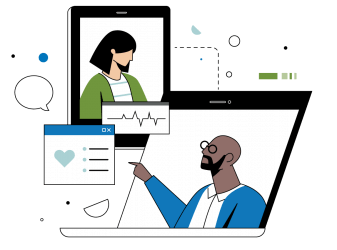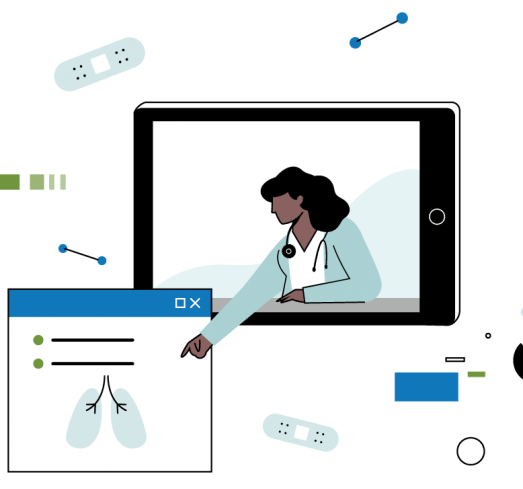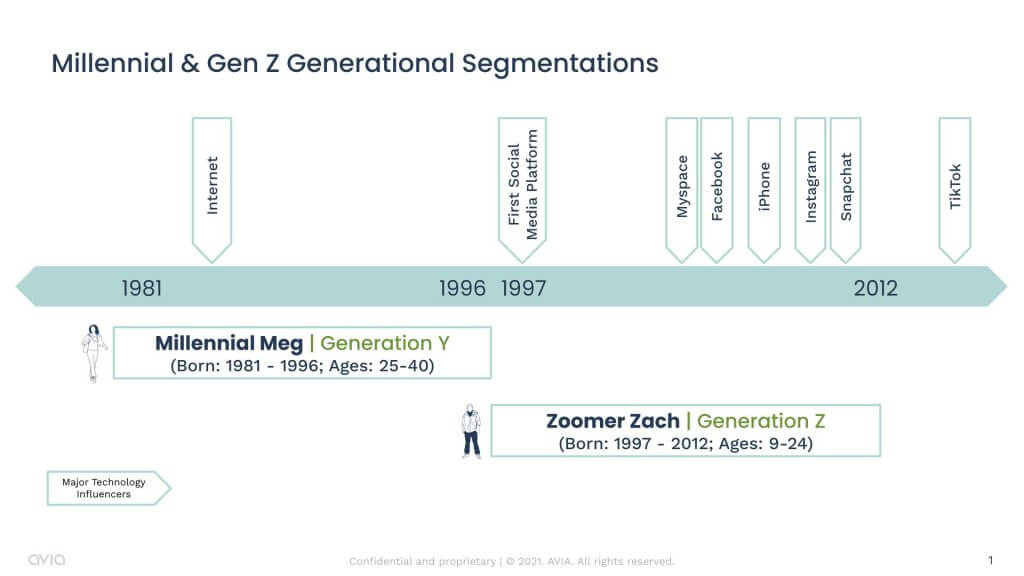
Virtual Visits in Healthcare: The Past, Present, and Future
AVIA
Insights
Sonia Singh, Vice President, and Betsy Hansen, Director, Center for Consumerism; and Christina Im, Analyst, Digital Impact Hub

It’s the era of millennials and Gen Z – over 50% of the US population falls in these two generations, making them the single largest consumer force today. And millennials and Gen Z are less accepting of the status quo than older generations. Instead, they’re pushing businesses from all industries to shift their business model to better meet their needs.
Healthcare is no exception – when surveyed, Gen Z reports being increasingly dissatisfied with the current healthcare model, and 51% of millennials visit a physician less than once a year. In order to capture market share and survive – and thrive – in the new world spearheaded by millennials and Gen Z, health systems must change how they’re communicating with, attracting, and caring for these younger generations. Let’s explore who these generations are and what they’re looking for in healthcare.

Millennials, also known as Generation Y, refers to people born between 1981-1996. The estimated Millennial population size in the US is 82.2 million, making them the second-largest living generation after Gen Z.
As consumers, millennials are shifting towards a preference for online shopping. They prefer purchasing from well-known, popular brands, seeking to achieve a “showcaser” status through brand recognition. However, physical goods don’t define the millennial experience – 72% of millennials prefer spending their money on experiences instead of gear or gadgets.
When it comes to their interactions with healthcare providers, millennials are looking for a quick, personalized, and convenient experience – unsurprisingly, 74% of millennials prefer telemedicine to in-person appointments. They like to make informed decisions and rely on recommendations, reviews, and price transparency to decide on doctors and care paths.
Sample Profile: Millennial Meg
Meg is 35 years old, born in 1986. She is married with two children and receives health insurance for her and her family through her employer. In the past, she has declined non-essential medical care because of the associated price. She does not have a primary care provider – instead, she will shop around to find a cost-effective provider with the digital tools to provide online portals and virtual visits. She is concerned about reaching “middle age” and the associated medical costs of getting older.
Generation Z, commonly referred to as Gen Z, encompasses people born between 1997 and 2012, ranging in age from 9-24. At 86.4 million people, they are the largest generation yet, as well as the most diverse by race, ethnicity and gender. According to Pew Research, 48% are ethnic minorities and 35% personally know someone who prefers to go by gender-neutral pronouns.
As consumers, Gen Z values and prioritizes sustainable, authentic, and inclusive retailers. They expect companies to take a stance on social justice issues and do not shy away from calling out brands that stay quiet. Breaking from millennials, they demand both online and in-person avenues for shopping, but have a growing interest in brick-and-mortar stores.
Gen Z is increasingly dissatisfied with the traditional healthcare model, and 45% do not have a primary care provider (PCP). Instead, they’re turning to holistic and preventative care, seeking out a convenient experience where they can have full autonomy over their health. As the first generation to grow up with the internet, they rely heavily on social media and online reviews to influence their healthcare decisions and seek out providers who can provide digital experiences.
Sample Profile: Zoomer Zach
Zach is 17 years old, born in 2004. He is a rising Youtube influencer and is graduating from high school this year. Although he’s still on his parent’s insurance, he is interested in preventative care and turns to social media for answers to the healthcare information that he needs. He is concerned that the traditional model of healthcare won’t meet his needs and looks for alternative ways to receive care.
The traditional healthcare model that baby boomers (1955-1964) and Gen X (1965-1980) have become accustomed to simply does not appeal to or attract millennials or Gen Z. The model that centers on a family doctor providing care over the long-term is being uprooted due to the new behaviors and decision-making patterns highlighted above, as well as an increased preference towards a semi-nomadic lifestyle among the younger generations.
Millennials and Gen Z are not loyal to their medical provider. Instead, they are willing to shop around and change providers based on convenience, price, and digital offerings. Additionally, a 2019 Accenture survey found that 37% of millennials and Gen Z are either dissatisfied or very dissatisfied with the location or channel of their care, and 44% report dissatisfaction around the effectiveness of the treatment.
A 2019 Accenture survey found that 37% of millennials and Gen Z are either dissatisfied or very dissatisfied with the location or channel of their care, and 44% report dissatisfaction around the effectiveness of the treatment.
Mental health condition diagnoses impact millennials and Gen Z more than older generations – 29.4% of people aged 18-25 have been diagnosed with a mental health condition, compared to 14.1% of those 50 years or older. This disparity translates into an increased focus on mental health and wellness in the younger generations.
Millennials and Gen Z are driving a growing demand for mental health and wellness treatments and services. They prioritize their mental health and independently approach their mental health problems, especially through stress management techniques and meditation. There is also less of a stigma around mental health in these younger generations, and they are more likely to share that they have utilized mental health treatment or therapy services than the older generations.
Both generations prefer to take a long-term holistic view of their health, instead of triaging health issues as they arise. You’ll find the younger generations seeking out virtual and in-person mental health services, mind & body wellness opportunities, and opportunities for physical fitness and exercise. This trend is reflected in the growing markets for wellness solutions – in 2018, the global market for mental health apps was $587.9 million, and it’s predicted to reach $3.9 billion by 2027.
When dealing with health issues or learning more about wellness, millennials and Gen Z are far less likely than older generations to turn to healthcare providers for support. Instead, you’ll find them consulting social media and talking to friends for answers. When surveyed, 80% of Gen Z and 74% of millennial consumers say that social media impacts their purchasing decisions.
While these generations are strongly loyal to certain wellness brands, they generally will not stay loyal to their PCP. Instead, they’ll switch providers depending on cost, location, and digital amenities offered. They also seek diversity from their healthcare providers and tend to trust providers that offer diverse representation.
When it comes to healthcare, convenience is a top priority for millennials and Gen Z. The generations grew up as the first “digital natives,” meaning their expectation for convenience, transparency, and speed in their digital interactions extends into healthcare. 71% of millennials want the ability to schedule appointments, access medical records, and receive automated appointment reminders online or through an app.
While Gen Z demands equal levels of convenience from their healthcare providers, there is a renewed interest from the younger generation around shifting back to brick-and-mortar experiences. However, their expectations drastically differ from what wellness visits of the past provided. They expect the experience to be convenient – no waiting rooms, contactless, quick, and easy to navigate – and if their in-person visit doesn’t live up to these expectations, they will take their business elsewhere.
Millennials and Gen Z are demanding a more convenient, accessible, and tailored healthcare experience, and health systems must start making changes to accommodate these generations’ needs today. Fortunately, health systems don’t need to build these programs from the ground up. Disruptors have been innovating to create solutions, wearables, and services that can provide a more personalized, convenient experience to your consumers.
Searching for partnerships beyond the four walls of your health system will help your system survive – and thrive – as millennials and Gen Z become the dominant consumer force in the United States. The four main areas where partnerships can make an impact include:
Partnerships with existing innovators can expand your health system’s current capabilities and help you attract – and maintain – millennial and Gen Z consumers. In our work with AVIA Member health systems, we focus on five main areas where partnerships can drive results:
As millennials and Gen Z shift away from the traditional healthcare model and look for convenience and wellness opportunities, health systems must shift with them in order to stay relevant in an increasingly competitive environment.
While implementing changes to appeal to the younger demographic may seem overwhelming, breaking it down into manageable steps and finding a strong digital solution partner is key for success. AVIA has partnered with 50+ health systems across the country to drive meaningful digital change and increase consumer acquisition and loyalty. If you’re ready to modernize your health system, contact us today.